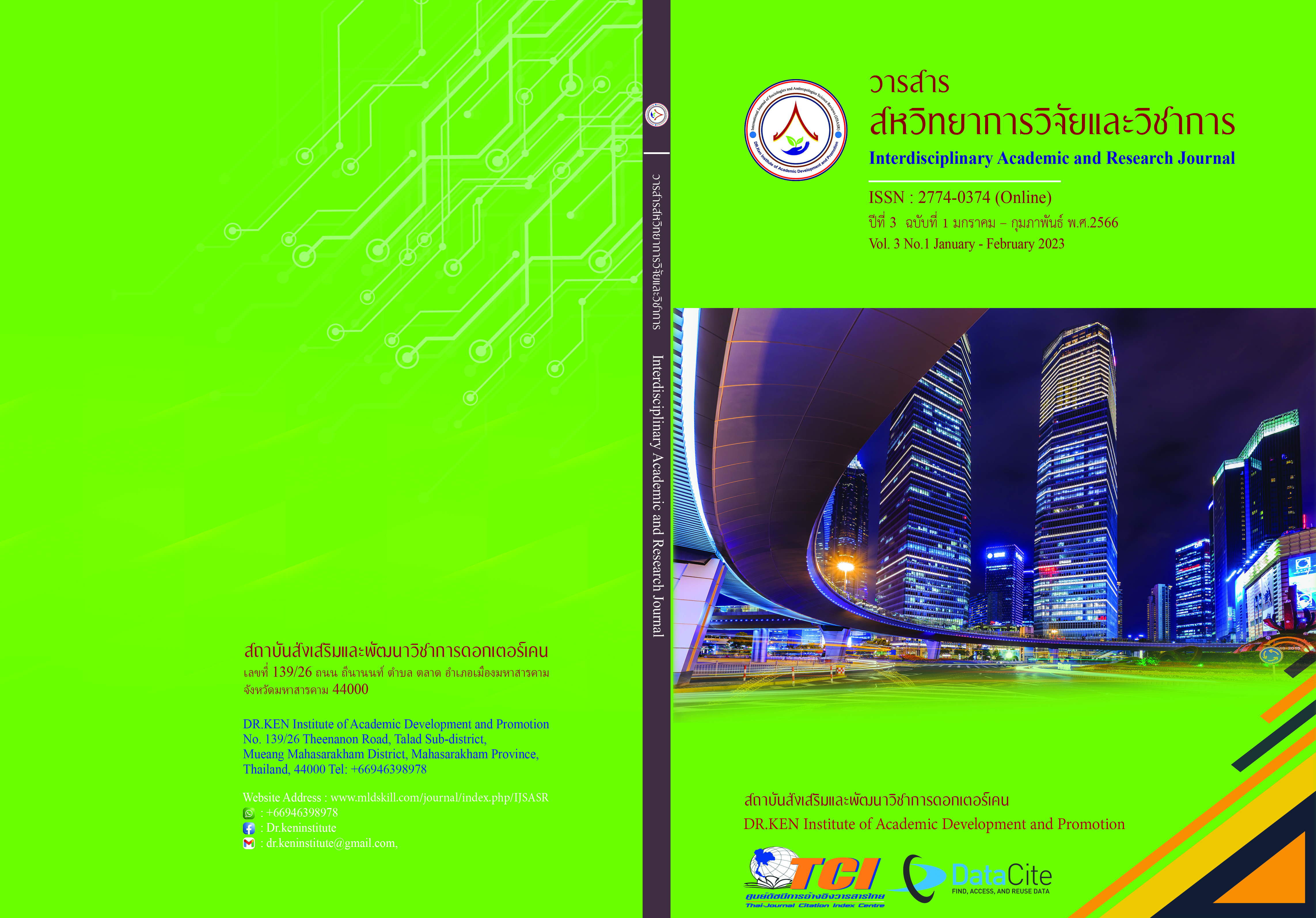Integrative Process Innovation for Formulation Human Resource Development to Enhance the Skills Needed in the 21st Century on the Basis of Ethnic Diversity Sakon Nakhon Province
DOI:
https://doi.org/10.14456/iarj.2023.44Keywords:
Process Innovation; , Human Resources; , 21st Century; , Ethnic GroupsAbstract
In the 21st century, human beings are faced with a dynamic environment. Technological advancement as a result of the development of scientific knowledge leads to modern innovations all the time. This article aims to study an innovative, integrative process for human resource development modeling to enhance necessary skills in the 21st century based on ethnic diversity in Sakon Nakhon Province. Ethnic groups living in Sakon Nakhon Province consist of the Tai Yo tribe, the Phu Tai tribe, the Tai Yoi tribe, and the Tai Ka So tribe. Tai Ka Loeng Tribe and Thai Lao people Each tribe has different traditions and traditions. But what they have in common is the production of indigo-dyed fabric. which almost all ethnic groups have inherited from their ancestors Bringing the skills needed in the 21st century to use both skills in using technology. adaptive skills to current situations creative thinking skills and skills to learn all the time It is an innovative, integrative process where ethnic groups in Sakon Nakhon Province pass on knowledge from the old generation to the new generation to keep up with the rapid changes in today's world.
References
กรุงศรี เพลิน เพลิน. (2565). 5 ทักษะที่คุณต้องปรับตัวในการทำงานยุคดิจิทัล. Retrieved February 16, 2023 from: https://www.krungsri.com/th/plearn-plearn/5-digital-skills
คณาจารย์วิชาวัฒนธรรมแอ่งสกลนคร มหาวิทยาลัยราชภัฏสกลนคร. (2554). วัฒนธรรมแอ่งสกลนคร. สกลนคร: ร้านสมศักดิ์การพิมพ์.
คณาจารย์วิชาวัฒนธรรมแอ่งสกลนคร. (2554). วัฒนธรรมแอ่งสกลนคร. สกลนคร: ร้านสมศักดิ์การพิมพ์.
จิรภัทร เริ่มศรี. (2562). กลยุทธ์การสื่อสารอัตลักษณ์ผ้าย้อมครามสกลนคร. วารสาร มจร สังคมศาสตร์ปริทรรศน์. 8(4), 178-190.
ฐิติทัตน์ นิพนธ์พิทยา. (2562). รูปแบบการพัฒนาทรัพยากรมนุษย์ในยุคไทยแลนด์ 4.0 ของหน่วยบัญชาการทหารพัฒนา กองบัญชาการกองทัพไทย. วารสารบัณฑิตศึกษามหาจุฬาขอนแก่น. 6(4), 757-773.
ณัฐพล บัวเปลี่ยนสี. (2564). การพัฒนารูปแบบนวัตกรรมการจัดการทรัพยากรมนุษย์ในยุคดิจิทัลสำหรับเขตพัฒนาพิเศษภาคตะวันออก. วารสารมณีเชษฐาราม วัดจอมมณี. 4(2), 1-16.
ปทุมทิพย์ ม่านโคกสูง. (2547). กลุ่มชาติพันธุ์ในจังหวัดสกลนคร. ศูนย์พัฒนาฟื้นฟูและเผยแพร่ ภูมิปัญญาท้องถิ่น:มหาวิทยาลัยราชภัฏสกลนคร.
เปรม โกษาแสง. (2565). การพัฒนาผลิตภัณฑ์ผ้าย้อมครามและการส่งเสริมการตลาดของผลิตภัณฑ์ผ้าย้อมคราม ของกลุ่มทอผ้าย้อมสีธรรมชาติบ้านพันนา ตำบลพันนา อำเภอสว่างแดนดิน จังหวัดสกลนคร. วารสารมหาวิทยาลัยนราธิวาสราชนครินทร์ สาขามนุษยศาสตร์และสังคมศาสตร์. 9(1), 91-113.
ศศิกาญจน์ นารถโคษา (2565) ได้ศึกษาการออกแบบและพัฒนาผลิตภัณฑ์ตกแต่งที่พักอาศัยจากเศษผ้าย้อมคราม ที่สะท้อนอัตลักษณ์จังหวัดสกลนคร. วารสารสถาปัตยกรรม การออกแบบและการก่อสร้าง คณะสถาปัตยกรรมศาสตร์ ผังเมืองและนฤมิตศิลป์ มหาวิทยาลัยมหาสารคาม. 4(1), 41-57.
สุเนตตา แซ่โก๊ะ และคณะ. (2564). การพัฒนาทรัพยากรมนุษย์ภายใต้การแข่งขันทางเศรษฐกิจของประเทศไทย. วารสารวิชาการมนุษยศาสตร์และสังคมศาสตร์. 8(1), 27-43.
สุเนตร ศรีหาคลัง. (2562). การเปลี่ยนแปลงทางวัฒนธรรม: ภาษาและการแต่งกายของชาวภูไทเรณูนครในภาคตะวันออกเฉียงเหนือของประเทศไทย. วารสารดุษฎีบัณฑิตทางสังคมศาสตร์. 9(3), 705-715.
เอกสิทธิ์ สนามทอง. (2562). การพัฒนาทรัพยากรมนุษย์ : แนวทางพัฒนาสู่ความสำเร็จขององค์การ. วารสารเกษมบัณฑิต. 20 (1), 64-77.
Delahaye. (2005). Human Resource Development: Adult Learning and Knowledge Management. Milton: John Wiley & Sons Australia, Ltd.
Gilley, Jerry W., Eggland, Steven A.,& Ann Gilley, Maycunich. (2002). Principles of Human Resource Development. 2nd edition. Reading, MA.: Perseus.
Nadler, L., & Wiggs, G. D. (1989). Managing Human Resource Development. San Francisco: Jossey-Bass.
Downloads
Published
How to Cite
Issue
Section
License
Copyright (c) 2023 ชุติเดช ยะภักดี

This work is licensed under a Creative Commons Attribution-NonCommercial-NoDerivatives 4.0 International License.
Copyright on any article in the Interdisciplinary Academic and Research Journal is retained by the author(s) under the under the Creative Commons Attribution-NonCommercial-NoDerivatives 4.0 International License. Permission to use text, content, images, etc. of publication. Any user to read, download, copy, distribute, print, search, or link to the full texts of articles, crawl them for indexing, pass them as data to software, or use them for any other lawful purpose. But do not use it for commercial use or with the intent to benefit any business.
















.png)


